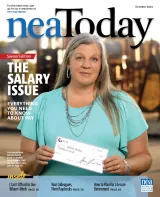This year, the Fairfax Education Association made history by ratifying its first collective bargaining agreement in nearly 50 years! The groundbreaking contract includes not only a 6 percent pay increase but also improved health-care benefits.
"This agreement transforms our education landscape," said Fairfax Education Association President Leslie Houston, when the agreement was ratified. "It demonstrates what we can achieve through collaboration and sets a new standard for educational excellence in our community."
The union negotiated the big bump in salary to help offset sharply rising health-care costs. What’s more, they bargained for a decrease in health-care premiums and out-of-pocket costs, as well as to speed up the districts search for a lower-cost health-care provider. Another major win was the establishment of a joint health-care committee, co-run by the union and the district.
"The idea behind creating this kind of health-care committee is that it will set our members up for many years, giving them the opportunity to choose their own health-care plan and obtain information from the district to create transparency and long-term stability of the reserve," says Cynthia Blankenship, with NEA’s Center for Collective Bargaining and Member Advocacy.
Since 2018, the overall cost of living in the United States has increased by 17 percent, but the cost of health insurance in general has increased by 45 percent, according to the Bureau of Labor Statistics (BLS). Some of those skyrocketing costs are being passed to educators. The latest BLS data shows that the average cost of a public school employees health benefit contributions (the portion of the premium paid by employees) increased by 14 percent between 2018 and 2022.
According to the latest national salary data, public school teachers’ salaries increased only 10 percent in the same time frame. In other words, health-insurance premiums and the general cost of living are increasing faster than educators’ pay raises.
With education budget cuts and a persistent shortage of health-care providers, costs will likely continue to rise. But armed with information, union members can make a difference.
Ask your local affiliate if your union has a health-care committee and if it has a seat at the table for decisions about health-care programs for school employees. Bargaining for lower health-care costs benefits the entire school community, including the district.
How unions and districts can work together on health care
Everyone in a school district has a shared interest in improving the quality and affordability of health-care benefits. Forming a joint labor-management benefits advisory committee (BAC), allows union and district staff to work together to examine health-care plans, share ideas, and find the best options for everyone. It’s a win-win for all parties!
Check with your union and district human resources office to see if a BAC already exists. If not, reach out to your union representative and share these reasons why your union and district should form a BAC, and how to get started.
- A BAC allows members to discuss the health-benefit needs and related financial constraints of employees throughout the year.
- It provides the opportunity for all stakeholders: employer, employee, the health plan, and other vendors to openly discuss what is and is not working.
- Members of the BAC should have an equal number of employers and employees, but not less than two of each.
- The BAC should survey members, analyze data, discuss details, and proposals, and report out to keep everyone in the school informed.
Check out NEA's report, Health Insurance Cost and the Impact on Salaries to learn strategies for protecting your health care and how to form a BAC. Share this resource with your union leaders and colleagues!



